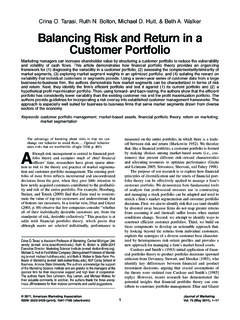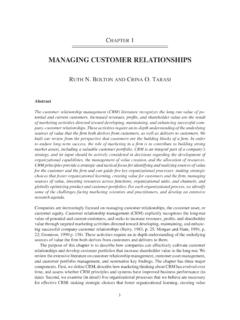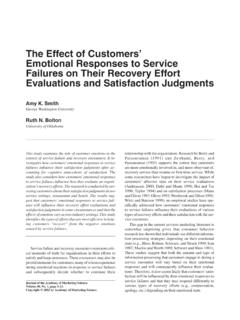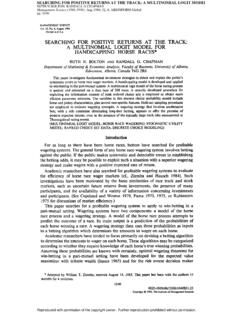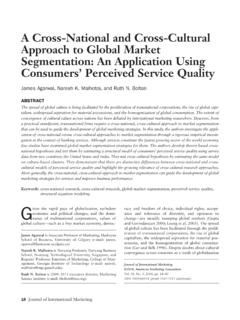Transcription of Understanding Generation Y and Generation Y and social ...
1 Understanding Generation Y andtheir use of social media:a review and research agendaRuth N. Bolton, A. Parasuraman, Ankie Hoefnagels,Nanne Migchels, Sertan Kabadayi, Thorsten Gruber,Yuliya Komarova Loureiro and David Solnet(Information about the authors can be found at the end of this article.)AbstractPurpose The purpose of this paper is to review what we know and don t know aboutGeneration Y s use of social media and to assess the implications for individuals, firms and The paper distinguishes Generation Y from other cohorts in termsof systematic differences in values, preferences and behavior that are stable over time (as opposed tomaturational or other differences).
2 It describes their social media use and highlights evidence ofintra-generational variance arising from environmental factors (including economic, cultural,technological and political/legal factors) and individual factors. Individual factors include stablefactors (including socio-economic status, age and lifecycle stage) and dynamic, endogenous factors(including goals, emotions, and social norms).The paper discusses how Generation Y s use of social mediainfluences individuals, firms and society. It develops managerial implications and a research Prior research on the social media use of Generation Y raises more questions than itanswers.
3 It: focuses primarily on the USA and/or (at most) one other country, ignoring other regionswith large and fast-growing Generation Y populations where social -media use and its determinantsmay differ significantly; tends to study students whose behaviors may change over their life cyclestages; relies on self-reports by different age groups to infer Generation Y s social media use; and doesnot examine the drivers and outcomes of social -media use. This paper s conceptual framework yields adetailed set of research This paper provides a conceptual framework for considering the antecedentsand consequences of Generation Y s social media usage.
4 It identifies unanswered questions aboutGeneration Y s use of social media, as well as practical insights for Y, Millenials, social media, Media use, Generation , Dark side, Digital media, social networking sites, social norms, social stratificationPaper typeResearch paperGeneration Y or the Millennial Generation exerts a peculiar fascination on both managersand academics. In what has become common parlance, members of Generation Y arecalled digital natives, rather than digital immigrants (Prensky, 2001). They are the firstgeneration to have spent their entire lives in the digital environment; informationtechnology profoundly affects how they live and work (Bennettet al.)
5 , 2008; Wesner andMiller, 2008). Generation Y actively contributes, shares, searches for and consumesThe current issue and full text archive of this journal is available authors gratefully acknowledge the editorial comments and advice of Lerzan M. Aksoy,Jay Kandampully and Allard Van Riel, as well as the reviewers. They also thank the participantsof the Thought Leadership Conference on Connections, Communities, and Collaboration: ServiceSustainability in the Digital Age hosted by Radboud University, in Nijmegen, The Netherlandsduring June 2012. All authors contributed equally to the 5 November 2012 Revised 10 January 2013 Accepted 30 January 2013 Journal of Service ManagementVol.
6 24 No. 3, 2013pp. 245-267qEmerald Group Publishing Limited1757-5818 DOI Yand social media245content plus works and plays on social media platforms. Service managers andresearchers are interested in Generation Y s social media usage because it may be aharbinger of how people will behave in the the popular press, articles about Generation Y have typically focused on the socialmedia usage patterns of young people of relatively high socio-economic status who livein developed countries where there is relatively unfettered access to informationtechnology and social media platforms. Yet, it is self-evident that (for example) Generation Y s social media usage in the USA is very different from South Korea due todifferences in culture and technological infrastructure and that rich people use socialmedia in different ways than poor people.
7 In this paper, we define Generation Y(broadly) as all people born between 1981 and 1999 regardless of their definition allows us to examine differences in social media usage across diversemembers of Generation Y living in different purpose of this paper is to review what we know and do not know aboutGeneration Y s use of social media and to assess the implications for individuals, firms andsociety. The paper describes a conceptual framework for Understanding Generation Y ssocial media use, its antecedents and its consequences. We believe that it is useful toexplore stable differences in values, preferences and behaviors across generational cohorts(or other market segments), but we caution against overgeneralization.
8 Hence, the paperconcludes by outlining a research agenda to address unanswered questions aboutGeneration Y s use of social organizations, managers, researchers and public policy makers are interestedin Generation Y s use of social media because it affects people s behavior in manydomains with positive and negative outcomes for customers, firms and their employees,and society. Generation Y s social media use affects consumers identity formation, theirexpectations regarding service, formation of habits, engagement with brands and firms,participation in value co-creation, brand loyalty, purchase behavior and lifetime value,and (ultimately) the value of the firm.
9 It thereby influences organizational decisions aboutservice customization and productivity, such as how resources are allocated betweenlabor and automation. It also profoundly influences the design and implementation ofinteractive services including location-based, retail and self-service technology(Berryet al., 2010) as well as customer relationship management practices. Moreover, Generation Y s use of social media has important ramifications for how firms hire andmanage employees. Last, social norms and behavior may be changing due to GenerationY s use of social media affecting civic engagement, attitudes toward privacy, nutrition,health care practices and public safety in the general paper begins by distinguishing Generation Y from other cohorts in terms ofsystematic differences in values, preferences and behavior that are stable over time(as opposed to maturational or other differences).
10 Next, we describe Generation Y ssocial media use and highlight evidence of intra-generational variance arising fromenvironmental factors affecting social media use, including economic, cultural,technological and political/legal factors, as well as individual factors beyond birthcohort. Individual differences arise from relatively stable factors, such as individuals socio-economic status, personal values/preferences, age and lifecycle stage as well asfrom transaction-specific, dynamic, factors such as their goals, emotions, and socialnorms that may both influence and be influenced by social media use.

